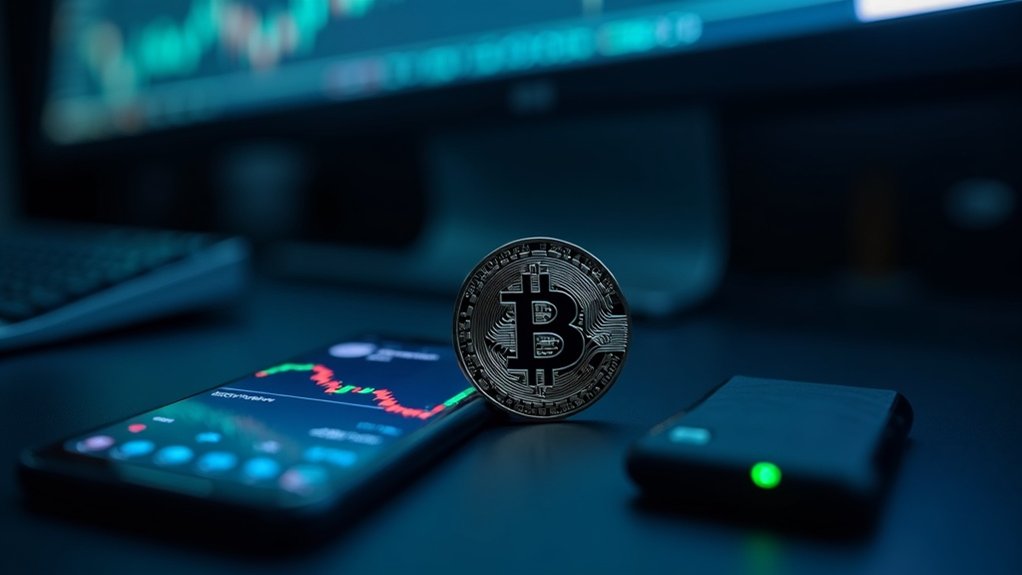Non-fungible tokens (NFTs) are unique digital certificates that prove ownership of digital or physical assets on the blockchain. Unlike cryptocurrencies, each NFT is one-of-a-kind and can’t be copied or replaced. They function through smart contracts that automatically manage buying and selling. NFTs commonly represent digital art, virtual real estate, gaming items, and collectibles. While anyone can share the associated digital file, only one person owns the authentic NFT. The technology continues to evolve with new applications emerging.

How do digital artists and creators prove ownership of their work in today’s online world?
Non-fungible tokens (NFTs) have emerged as a solution, providing a way to establish and verify digital ownership through blockchain technology.
These unique digital tokens serve as certificates of authenticity that can’t be copied or replaced.
NFTs stand as digital proof of authenticity, creating a unique and immutable record that verifies true ownership in the digital space.
Unlike cryptocurrencies, where one Bitcoin can be exchanged for another Bitcoin of equal value, each NFT is unique.
They contain special digital signatures that make them one-of-a-kind, similar to how each painting in a museum is distinct.
While both use blockchain technology, NFTs serve as digital ownership certificates rather than a medium of exchange like cryptocurrencies.
These tokens are recorded on a blockchain, which acts like a public digital ledger that tracks who owns what.
The technology behind NFTs relies on something called smart contracts, with the most common standard being ERC721 on the Ethereum blockchain.
These contracts automatically manage how NFTs are created, bought, and sold.
Anyone can create an NFT through various platforms, even without coding knowledge.
The NFT standard was developed after stakeholder voting determined the best terminology to use during the ERC-721 drafting phase.
When someone buys an NFT, the transaction is permanently recorded on the blockchain for everyone to see.
NFTs first gained prominence in 2018 when the ERC721 standard was introduced to define unique tokens with distinct attributes.
It’s important to note that owning an NFT doesn’t necessarily mean owning the copyright to the digital artwork or item it represents.
Instead, it proves you own the original version, even if others can still copy and share the digital file.
Think of it like owning an original painting versus having a print of that painting.
NFTs aren’t just for digital art.
They’re being used for virtual real estate, gaming items, music, collectibles, and even physical assets like concert tickets or luxury goods.
Creators can sell their work directly to buyers and even earn royalties when their NFTs are resold later.
The NFT market has seen dramatic changes, growing from $82 million in 2020 to $17 billion in 2021.
However, recent data shows that most NFT collections don’t hold monetary value, highlighting the volatile nature of this technology.
Despite this volatility, NFTs continue to offer new ways for creators to monetize their work and for collectors to verify ownership of digital assets.
Frequently Asked Questions
Can NFTS Lose Value Over Time?
Yes, NFTs can and do lose value over time.
Market data shows many NFTs have lost over 90% of their original worth within a few years.
This value loss often happens when initial excitement fades and fewer people want to buy them.
While some utility-focused NFTs (like digital tickets or memberships) might hold value better, the market’s unpredictable nature means prices can drop substantially.
Current trends show declining revenue forecasts through 2026.
What Happens to an NFT if the Hosting Platform Shuts Down?
When a platform shuts down, NFTs remain on the blockchain but accessing them becomes more difficult.
While ownership records stay intact, users may lose easy access to their digital assets through the platform’s interface.
The biggest risk involves NFTs whose artwork is stored on the platform’s servers – these images could disappear if servers go offline.
However, users can often still trade their NFTs through other marketplaces that support blockchain transactions.
Are NFTS Environmentally Friendly?
NFTs aren’t typically environmentally friendly.
Each NFT minting process produces about 80kg of carbon dioxide, similar to what 1.38 trees can absorb.
Secondary transactions like sales and transfers add 23-51kg more.
However, recent improvements are making NFTs greener.
The Ethereum blockchain’s switch to a more efficient system in 2022 cut energy use by 99.95%.
Some platforms now use eco-friendly blockchains and carbon offset programs.
Can Someone Copy and Sell My NFT Without Permission?
Yes, someone can copy and share the digital artwork linked to an NFT, but they can’t legally sell it without permission from the copyright holder.
While anyone can save or screenshot the image, only the NFT owner possesses the unique blockchain token proving ownership.
Copyright law protects creators from unauthorized sales of their work.
NFT platforms often use takedown notices to remove unauthorized copies, though enforcement remains challenging in the digital space.
Which Cryptocurrency Is Most Commonly Used to Purchase NFTS?
Ethereum (ETH) is the most commonly used cryptocurrency for purchasing NFTs.
While other cryptocurrencies like Solana and Binance Coin are gaining popularity, Ethereum dominates the NFT market due to its widespread adoption and smart contract capabilities.
Data shows that major NFT marketplaces like OpenSea and Rarible primarily use Ethereum for transactions.
Ethereum’s market cap of $471 billion reflects its leading position in NFT trading and smart contracts.









